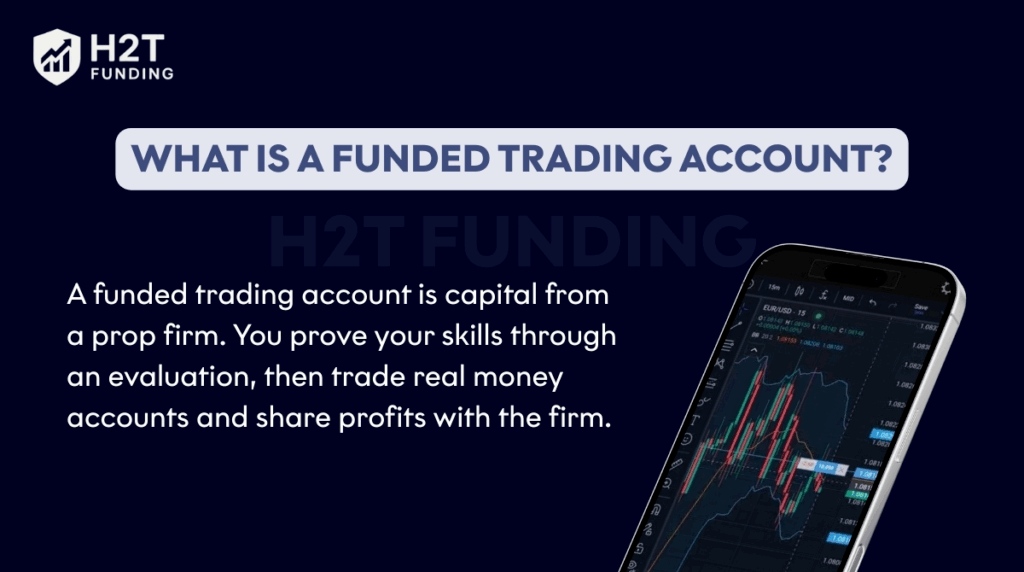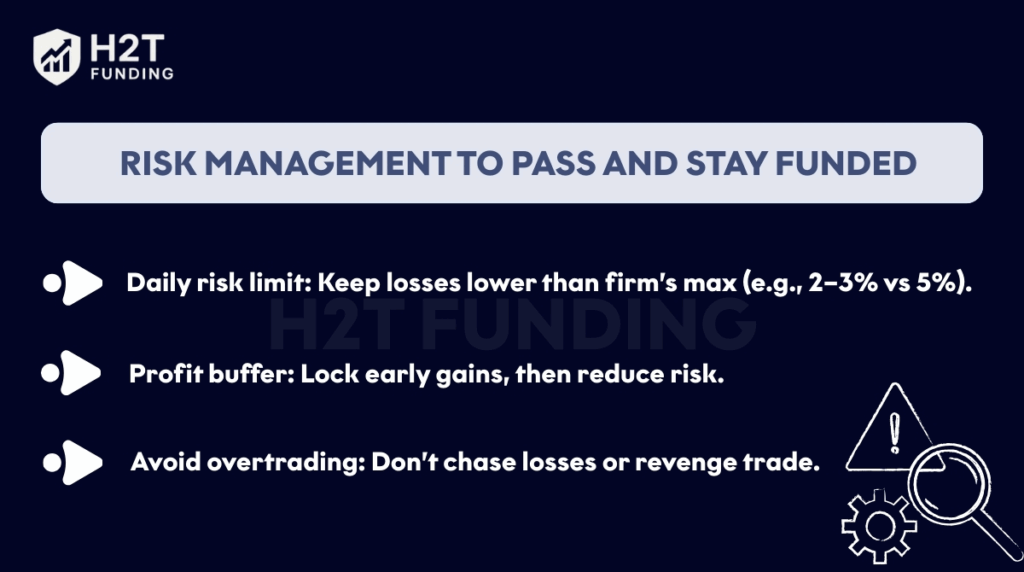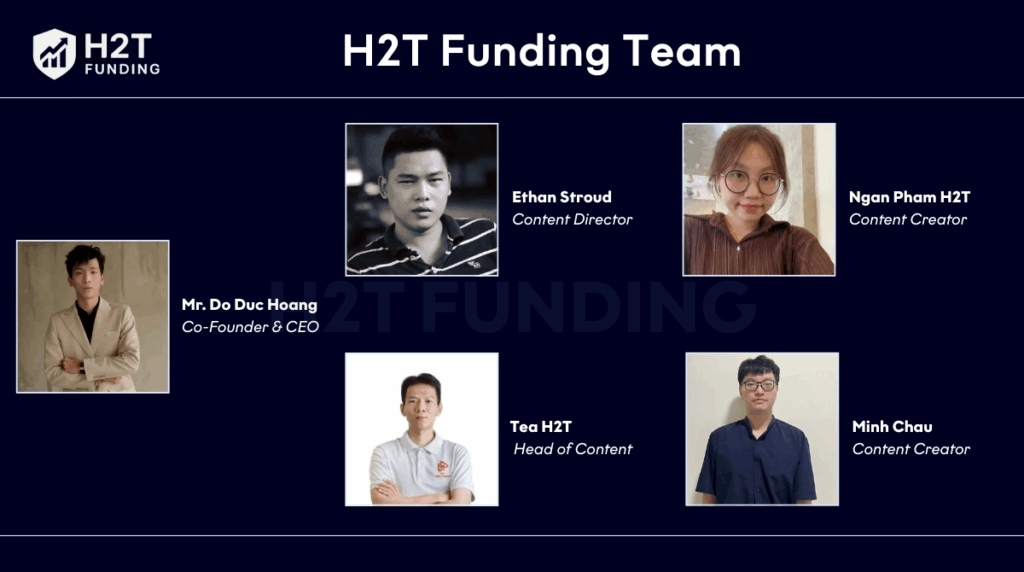The first time you hear about a funded trading account, it can feel unreal because it promises scale without risking personal savings. Many traders then ask a single question: How to get a funded trading account?
In this guide, H2T Funding explains what a funded account is, why it exists, and the steps to reach it. Let’s start with the basics.
1. What is a funded trading account?
Before applying, you need to understand what a funded account is and how it differs from trading your own money.
A funded trading account is capital provided by a proprietary trading firm. Instead of depositing personal funds, you complete an evaluation to prove you can follow rules and manage risk. If you succeed, you gain access to a trading account that can range from tens of thousands of dollars to six figures. Profits generated are shared between you and the firm.
The model is based on profit sharing. In most agreements, traders keep a large portion of profits, often between 70% and 90%. The firm retains the rest in exchange for providing capital, risk oversight, and infrastructure.

What is a funded trading account?
As Investopedia (2023) explains, prop firms “leverage skilled traders to generate profits for the company while allowing those traders to avoid risking their own capital.”
Funded accounts also come with strict guardrails that protect the firm’s capital. These usually include:
- Daily and overall drawdown limits.
- Restrictions on certain strategies, such as high-risk news trading.
- Monitoring to ensure all rules are followed.
Violating these conditions can result in losing the account, even if you were making profits. This structure pushes traders to focus on consistency, discipline, and process rather than chasing short-term wins.
2. How to get a funded trading account (step by step)
Getting a funded account is not simply about being profitable for a few trades. Prop firms structure the process to test discipline, rule-following, and consistency under pressure. Each stage confirms whether you can protect capital as well as grow it. To succeed, traders usually go through four main steps:
- Step 1: Choose the right prop firm.
- Step 2: Meet requirements and apply.
- Step 3: Pass the evaluation challenge.
- Step 4: Sign the agreement and start trading.
Let’s break down each step in detail.
2.1. Step 1: Choose the right prop firm
The first decision is selecting the funding model that matches your goals and trading style. Most prop firms provide three common options:
- One-step challenge: Requires you to hit a profit target in a single phase. It is fast but leaves little room for recovery if you make mistakes. Rules are usually strict, with tighter drawdown limits.
- Two-step challenge: Divides the evaluation into two phases. The profit target in each step is smaller, and the trader has more time to prove consistency. Many experienced traders recommend this model because it allows room to adjust if the first phase is not perfect.
- Instant funding: Lets you skip the challenge and trade live capital immediately after paying higher fees. This option is faster, but the cost can be significant, and the risk of losing the account without practice is high.

Step 1: Choose the right prop firm
In practice, scalpers who thrive on quick setups often prefer one-step programs. Swing traders, who hold positions for several days, usually succeed with two-step challenges. Beginners often feel more comfortable starting with a two-step model because the rules are more forgiving.
2.2. Step 2: Meet requirements and apply
Once you choose a firm, the application process begins. Typically, you must:
- Register on the firm’s website.
- Pay the program or challenge fee, which ranges from $100 to over $1,000 depending on account size.
- Agree to rules and conditions, including risk limits, strategy restrictions, and payout policies.
This stage may sound simple, but overlooking details here causes many traders to lose accounts.
The Commodity Futures Trading Commission (CFTC, 2023) highlights that clear knowledge of trading conditions protects both firms and participants.
For example, some firms restrict trading during news events or disallow overnight positions. These rules can easily catch traders off guard if not carefully reviewed.
2.3. Step 3: Pass the evaluation challenge
The evaluation is the heart of the process. It is not about chasing profits but about showing the ability to combine gains with risk control. Common requirements include:
- Profit target: Usually 8–10% within a set period, such as 30 days.
- Drawdown limits: Often capped at 5% daily or 10% overall.
- Minimum trading days: Some firms require 5–10 active trading days to confirm consistency.
Traders who succeed rarely do so by using maximum leverage. Instead, they use smaller lot sizes, risk less than 1% per trade, and focus on quality setups. I once worked with a trader who passed a $50,000 challenge by taking only two high-probability trades per week. By waiting for strong confirmations, he avoided emotional entries and kept his drawdown at just 2%.
Evaluations are designed to measure consistency and discipline. If you treat them like real trading instead of a temporary test, your chances of passing improve significantly.
2.4. Step 4: Sign the agreement and start trading
After you pass the evaluation, the firm offers a contract granting access to live capital. At this stage:
- You begin trading with real funds provided by the firm.
- Payouts are scheduled, usually every two weeks or monthly, with profit splits between 70% and 90% for the trader.
- Some firms also provide scaling opportunities, allowing account sizes to increase when consistent profitability is demonstrated.
Many traders describe this step as their first entry into professional trading. It shifts the mindset from testing strategies to managing capital responsibly for both yourself and the firm. With consistent performance, this stage can become the foundation for a long-term trading career.
3. Key rules every trader must know
When learning how to get a funded trading account, it is important to understand that success is not only about hitting profit targets. Funded accounts come with strict rules that protect the firm’s capital and ensure traders apply responsible risk management. Ignoring these rules is one of the fastest ways to lose access to funding.
3.1. Profit targets and drawdown limits
Every prop firm sets profit targets that traders must reach during evaluation and sometimes even after funding. Alongside this, there are drawdown rules:
- Daily drawdown: Maximum loss you can take in a single day.
- Maximum drawdown: Overall limit for the account, often set as a static number or trailing level.
For example, a $100,000 account might have a $5,000 maximum drawdown. If equity falls below $95,000, the account is closed. Traders must always check whether the firm uses static or trailing drawdown, since it changes risk management dramatically.
3.2. Strategy restrictions
Not every trading style is allowed. Common restrictions include:
- News trading during high-impact events.
- Use of Expert Advisors (EAs) or bots without approval.
- Copy trading from another account.
- Lot size limits to prevent over-leverage.
These restrictions are designed to prevent high-risk behavior that could harm the firm’s capital. I’ve seen skilled traders lose funded accounts simply because they ignored lot size rules or opened positions minutes before major news releases.
3.3. Payout and scaling rules
Funded accounts often include payout schedules and scaling opportunities. Typical payouts are every two weeks or monthly, with profit splits ranging from 70% to 90% for the trader. Some firms also offer scaling plans, where consistent performance increases account size over time.
As Jack Schwager wrote in Market Wizards (2012), “Consistent performance, not big wins, is what separates long-term winners from short-term players.” Scaling programs reward exactly that consistency, giving disciplined traders a chance to manage larger capital without extra fees.
4. Risk management to pass and stay funded
Even if you know the rules, success in a funded account depends on risk management. Traders who survive and grow with prop firms all apply strict controls to protect both their account and their mindsets:
- Daily risk limits:
Setting a personal daily loss cap below the firm’s maximum drawdown is crucial. For example, if the firm allows 5% daily loss, many experienced traders keep their own limit at 2–3%. This creates a safety margin and prevents the account from being lost in one bad day.
- Build a profit buffer:
One common tactic is to lock in early profits to create a buffer.
For instance, if the challenge requires 10% profit, reaching 4–5% quickly gives breathing space. At that point, traders often reduce risk per trade, protecting both their gains and their evaluation status.
- Avoid overtrading and revenge trading:
Overtrading is one of the biggest reasons traders fail funded challenges. After a loss, the temptation to take more trades and “win it back” often leads to bigger drawdowns.

Risk management to pass and stay funded
Alexander Elder, in Trading for a Living (2014), warned that “the market will always tempt you to trade more, but discipline is the only defense.” A strict trade plan and a clear stop time each day are essential for avoiding emotional mistakes.
5. Choosing the right prop firm
Not all prop firms are the same. The best choice depends on fees, profit splits, and community trust. Careful selection can make the difference between a smooth trading journey and constant frustration.
5.1. Fee structure and refund policy
Most firms charge an upfront fee for challenges. Some refund this fee after you pass, while others do not. For example, a $500 challenge fee may be returned with your first payout. Always check refund terms before committing.
5.2. Profit split and payout schedule
Payout policies vary. Common splits range from 70% to 90% for the trader, with payouts every two weeks or once per month. A higher split sounds attractive, but the reliability of payouts is just as important. Reading reviews on platforms like Trustpilot helps confirm if firms pay on time.
5.3. Trading conditions and community reputation
Consider spreads, execution speed, and permitted strategies. Some firms ban trading during news or limit maximum lot sizes. Community reputation also matters. On forums like Reddit, traders often share first-hand experiences about which firms honor payouts and which are less transparent.
In my experience, traders who take the time to compare multiple firms, looking at both numbers and reputation, are more likely to find a reliable partner for long-term growth.
6. Common mistakes to avoid
Many traders fail funded accounts not because of poor strategy but because of avoidable errors. Recognizing these mistakes can save both time and money.
6.1. Using excessive leverage during the challenge
Over-leverage is one of the fastest ways to hit drawdown limits. Even if a big trade works once, it sets a risky habit that often leads to failure in the long run. Successful traders usually risk less than 1–2% per trade.
6.2. Misunderstanding trailing drawdown
Some firms use trailing drawdown, which moves up as your balance increases. Traders often miscalculate this and end up breaching rules. Always confirm whether the firm applies static or trailing drawdown before starting.
6.3. Trading during restricted news events
High-impact news like NFP (Non-Farm Payrolls) or FOMC announcements are restricted in many firms. Entering trades during these events, even if profitable, can invalidate the account. Always double-check the firm’s news trading policy.
By avoiding these pitfalls, you give yourself a much higher chance of passing evaluations and keeping your funded account active.
7. About H2T Funding
Founded in 2025, H2TFunding was built with a clear vision: to empower traders worldwide through transparent, accurate, and trustworthy information about proprietary trading firms. In an industry often clouded by unclear rules and exaggerated promotions, H2T Funding quickly became a reliable partner for thousands of traders across more than 150 countries.
What makes H2T Funding different is its focus on clarity and fairness. Instead of rankings or paid promotions, the platform delivers:
- Prop Firms Reviews: Independent evaluations of top proprietary trading firms worldwide, based on real rules and trader feedback.
- Prop Firm Rules: Clear breakdowns of profit splits, drawdown policies, and trading conditions to remove uncertainty.
- Strategies: Practical insights into budgeting, cash flow management, and trading approaches for passing challenges and scaling accounts.
- Resource: A growing library of guides, tools, and continuous updates to keep traders informed about market changes and funding opportunities.
Behind the platform is a dedicated team of professionals who combine global market expertise with strong communication skills:
- Mr. Do Duc Hoang – Co-Founder & CEO with over 15 years of Forex trading experience at international banks, guiding strategic direction.
- Ethan Stroud – Content Director, financial publishing expert with 10 years at Click Media (WPP Group).
- Tea H2T – Head of Content, financial analyst delivering in-depth insights on market movements and trading strategies.
- Ngan Pham H2T – Content Creator, economics-trained marketer simplifying complex financial concepts.
- Minh Chau – Content Writer, researcher producing concise and actionable financial analyses.

H2T Funding – Professional team
With this team and its trader-first approach, H2T Funding has become more than a resource hub. It is a strategic ally for day traders and professionals alike, helping them choose the right funding programs, avoid hidden risks, and build sustainable trading careers.
8. FAQs
New traders often have similar questions when considering funded accounts. Below are clear answers to some of the most common ones.
8.1. How long does it take to get a funded account?
The timeline depends on the type of program. A one-step challenge can take a few weeks, while a two-step program may take 1–3 months. Instant funding programs grant access immediately after payment and agreement, but usually at a higher cost.
8.2. Is a one-step or two-step challenge easier?
Two-step challenges are often considered easier because they allow more time and flexible conditions to show consistency. One-step models are faster but usually come with stricter rules and tighter drawdown limits.
8.3. Can beginners apply for a funded account?
Yes. Many prop firms accept beginners as long as they meet the requirements. However, new traders should practice on demo accounts first and develop basic risk management skills before committing money to a challenge.
8.4. How are taxes handled on profits from prop firms?
Tax rules vary by country. Most firms pay traders as independent contractors, which means you are responsible for reporting profits to local tax authorities. It is best to consult a tax advisor in your jurisdiction for specific guidance.
9. Conclusion
This guide has shown that learning how to get a funded trading account is a structured process rather than a mystery. From selecting the right prop firm to meeting requirements, passing the evaluation, and respecting trading rules, every stage builds the foundation for long-term success.
In my own experience, success in challenges came when I treated the evaluation like real trading, focusing on discipline and steady results instead of chasing profits. That mindset shift made the funded account more achievable and sustainable.
If you are ready to begin your own journey, visit H2T Funding for detailed reviews, comparison tools, and resources designed to guide you step by step toward securing and keeping a funded trading account.
Contact information:
- Website: https://h2tfunding.com/
- Office address: LV 4, 4/567 Group 10, Hoa Lan 1 Residential Area, Thuan An, Binh Duong, Viet Nam
- Email: [email protected]
- Fanpage: https://www.facebook.com/h2tfunding
- YouTube: https://www.youtube.com/@h2tfunding
- Office hours: Monday–Friday, 9:00 AM – 5:00 PM EST





